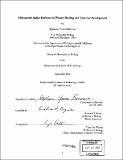Fibronectin splice isoforms in wound healing and vascular development
Author(s)
Burrows, Stephanie Yvonne, 1974-
DownloadFull printable version (5.878Mb)
Other Contributors
Massachusetts Institute of Technology. Dept. of Biology.
Advisor
Richard O. Hynes.
Terms of use
Metadata
Show full item recordAbstract
Fibronectins are a large family of extracellular matrix proteins that regulate cell adhesion, migration, differentiation and survival. Different isoforms of fibronectin arise via alternative splicing of the transcript of a single gene. Although many of the general functions of fibronectins have been elucidated, few specific functions of the alternatively spliced isoforms have been described. Studies of the expression patterns of the splice isoforms show that these proteins are present at high levels during embryonic development. In adult animals, these isoforms are expressed around the perimeter of blood vessels and are induced in response to injury. We have developed an in vitro system using a set of bacterially expressed fibronectins and fibronectin-null cells to look at the functions of the alternatively spliced isoforms in wound healing and vascular development. Our results indicate that the bacterially expressed fibronectins are fully functional and promote a number of well-established fibronectin functions. Therefore, these fusion proteins should be useful for investigations of splice isoform specific functions. Our experiments with fibronectin-null cells show that fibronectin negatively regulates the expression of the differentiation marker a-smooth muscle actin which is expressed by myofibroblasts during wound healing and by peri-endothelial cells during blood vessel development.
Description
Thesis (Ph.D.)--Massachusetts Institute of Technology, Dept. of Biology, 2002. Includes bibliographical references (leaves 173-186).
Date issued
2002Department
Massachusetts Institute of Technology. Department of BiologyPublisher
Massachusetts Institute of Technology
Keywords
Biology.